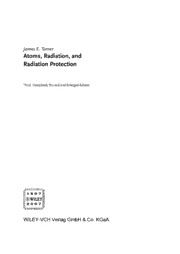
Atoms, radiation, and radiation protection PDF
Preview Atoms, radiation, and radiation protection
James E. Turner Atoms, Radiation, and Radiation Protection Third,CompletelyRevisedandEnlargedEdition TheAuthor AllbookspublishedbyWiley-VCHare carefullyproduced.Nevertheless,authors, J.E.Turner editors,andpublisherdonotwarrantthe 127WindhamRoad informationcontainedinthesebooks, OakRidge,TN37830 includingthisbook,tobefreeoferrors. USA Readersareadvisedtokeepinmindthat statements,data,illustrations,procedural detailsorotheritemsmayinadvertentlybe inaccurate. LibraryofCongressCardNo.: appliedfor BritishLibraryCataloguing-in-PublicationData Acataloguerecordforthisbookisavailable fromtheBritishLibrary. Bibliographicinformationpublishedby theDeutscheNationalbibliothek TheDeutscheNationalbibliothekliststhis publicationintheDeutsche Nationalbibliografie;detailedbibliographic dataareavailableintheInternetat <http://dnb.d-nb.de>. ©2007WILEY-VCHVerlagGmbH&Co. KGaA,Weinheim Allrightsreserved(includingthoseof translationintootherlanguages).Nopartof thisbookmaybereproducedinanyform–by photoprinting,microfilm,oranyother means–nortransmittedortranslatedintoa machinelanguagewithoutwritten permissionfromthepublishers.Registered names,trademarks,etc.usedinthisbook, evenwhennotspecificallymarkedassuch, arenottobeconsideredunprotectedbylaw. Typesetting VTEX,Vilnius,Lithuania Printing betz-druckGmbH,Darmstadt Binding Litges&DopfGmbH,Heppenheim WileyBicentennialLogo RichardJ.Pacifico PrintedintheFederalRepublicofGermany Printedonacid-freepaper ISBN 978-3-527-40606-7 ToRenate VII Contents PrefacetotheFirstEdition XV PrefacetotheSecondEdition XVII PrefacetotheThirdEdition XIX 1 AboutAtomicPhysicsandRadiation 1 1.1 ClassicalPhysics 1 1.2 DiscoveryofXRays 1 1.3 SomeImportantDatesinAtomicandRadiationPhysics 3 1.4 ImportantDatesinRadiationProtection 8 1.5 SourcesandLevelsofRadiationExposure 11 1.6 SuggestedReading 12 2 AtomicStructureandAtomicRadiation 15 2.1 TheAtomicNatureofMatter(ca.1900) 15 2.2 TheRutherfordNuclearAtom 18 2.3 Bohr’sTheoryoftheHydrogenAtom 19 2.4 SemiclassicalMechanics,1913–1925 25 2.5 QuantumMechanics 28 2.6 ThePauliExclusionPrinciple 33 2.7 AtomicTheoryofthePeriodicSystem 34 2.8 Molecules 36 2.9 SolidsandEnergyBands 39 2.10 ContinuousandCharacteristicXRays 40 2.11 AugerElectrons 45 2.12 SuggestedReading 47 2.13 Problems 48 2.14 Answers 53 3 TheNucleusandNuclearRadiation 55 3.1 NuclearStructure 55 Atoms,Radiation,andRadiationProtection.JamesE.Turner Copyright©2007WILEY-VCHVerlagGmbH&Co.KGaA,Weinheim ISBN:978-3-527-40606-7 VIII Contents 3.2 NuclearBindingEnergies 58 3.3 AlphaDecay 62 3.4 BetaDecay(β–) 65 3.5 Gamma-RayEmission 68 3.6 InternalConversion 72 3.7 OrbitalElectronCapture 72 3.8 PositronDecay(β+) 75 3.9 SuggestedReading 79 3.10 Problems 80 3.11 Answers 82 4 RadioactiveDecay 83 4.1 Activity 83 4.2 ExponentialDecay 83 4.3 SpecificActivity 88 4.4 SerialRadioactiveDecay 89 SecularEquilibrium(T (cid:1)T ) 89 1 2 GeneralCase 91 TransientEquilibrium(T (cid:1)T ) 91 1 2 NoEquilibrium(T <T ) 93 1 2 4.5 NaturalRadioactivity 96 4.6 RadonandRadonDaughters 97 4.7 SuggestedReading 102 4.8 Problems 103 4.9 Answers 108 5 InteractionofHeavyChargedParticleswithMatter 109 5.1 Energy-LossMechanisms 109 5.2 MaximumEnergyTransferinaSingleCollision 111 5.3 Single-CollisionEnergy-LossSpectra 113 5.4 StoppingPower 115 5.5 SemiclassicalCalculationofStoppingPower 116 5.6 TheBetheFormulaforStoppingPower 120 5.7 MeanExcitationEnergies 121 5.8 TableforComputationofStoppingPowers 123 5.9 StoppingPowerofWaterforProtons 125 5.10 Range 126 5.11 Slowing-DownTime 131 5.12 LimitationsofBethe’sStopping-PowerFormula 132 5.13 SuggestedReading 133 5.14 Problems 134 5.15 Answers 137 Contents IX 6 InteractionofElectronswithMatter 139 6.1 Energy-LossMechanisms 139 6.2 CollisionalStoppingPower 139 6.3 RadiativeStoppingPower 144 6.4 RadiationYield 145 6.5 Range 147 6.6 Slowing-DownTime 148 6.7 ExamplesofElectronTracksinWater 150 6.8 SuggestedReading 155 6.9 Problems 155 6.10 answers 158 7 PhenomenaAssociatedwithCharged-ParticleTracks 159 7.1 DeltaRays 159 7.2 RestrictedStoppingPower 159 7.3 LinearEnergyTransfer(LET) 162 7.4 SpecificIonization 163 7.5 EnergyStraggling 164 7.6 RangeStraggling 167 7.7 MultipleCoulombScattering 169 7.8 SuggestedReading 170 7.9 Problems 171 7.10 Answers 172 8 InteractionofPhotonswithMatter 173 8.1 InteractionMechanisms 173 8.2 PhotoelectricEffect 174 8.3 Energy–MomentumRequirementsforPhotonAbsorptionbyan Electron 176 8.4 ComptonEffect 177 8.5 PairProduction 185 8.6 PhotonuclearReactions 186 8.7 AttenuationCoefficients 187 8.8 Energy-TransferandEnergy-AbsorptionCoefficients 192 8.9 CalculationofEnergyAbsorptionandEnergyTransfer 197 8.10 SuggestedReading 201 8.11 Problems 201 8.12 Answers 207 9 Neutrons,Fission,andCriticality 209 9.1 Introduction 209 9.2 NeutronSources 209 X Contents 9.3 ClassificationofNeutrons 214 9.4 InteractionswithMatter 215 9.5 ElasticScattering 216 9.6 Neutron–ProtonScatteringEnergy-LossSpectrum 219 9.7 Reactions 223 9.8 EnergeticsofThresholdReactions 226 9.9 NeutronActivation 228 9.10 Fission 230 9.11 Criticality 232 9.12 SuggestedReading 235 9.13 Problems 235 9.14 Answers 239 10 MethodsofRadiationDetection 241 10.1 IonizationinGases 241 IonizationCurrent 241 WValues 243 IonizationPulses 245 Gas-FilledDetectors 247 10.2 IonizationinSemiconductors 252 BandTheoryofSolids 252 Semiconductors 255 SemiconductorJunctions 259 RadiationMeasuringDevices 262 10.3 Scintillation 266 General 266 OrganicScintillators 267 InorganicScintillators 268 10.4 PhotographicFilm 275 10.5 Thermoluminescence 279 10.6 OtherMethods 281 ParticleTrackRegistration 281 OpticallyStimulatedLuminescence 282 DirectIonStorage(DIS) 283 Radiophotoluminescence 285 ChemicalDosimeters 285 Calorimetry 286 CerenkovDetectors 286 10.7 NeutronDetection 287 SlowNeutrons 287 IntermediateandFastNeutrons 290 10.8 SuggestedReading 296 10.9 Problems 296 10.10 Answers 301 Contents XI 11 Statistics 303 11.1 TheStatisticalWorldofAtomsandRadiation 303 11.2 RadioactiveDisintegration—ExponentialDecay 303 11.3 RadioactiveDisintegration—aBernoulliProcess 304 11.4 TheBinomialDistribution 307 11.5 ThePoissonDistribution 311 11.6 TheNormalDistribution 315 11.7 ErrorandErrorPropagation 321 11.8 CountingRadioactiveSamples 322 GrossCountRates 322 NetCountRates 324 OptimumCountingTimes 325 CountingShort-LivedSamples 326 11.9 MinimumSignificantMeasuredActivity—Type-IErrors 327 11.10 MinimumDetectableTrueActivity—Type-IIErrors 331 11.11 CriteriaforRadiobioassay,HPSNl3.30-1996 335 11.12 InstrumentResponse 337 EnergyResolution 337 DeadTime 339 11.13 MonteCarloSimulationofRadiationTransport 342 11.14 SuggestedReading 348 11.15 Problems 349 11.16 Answers 359 12 RadiationDosimetry 361 12.1 Introduction 361 12.2 QuantitiesandUnits 362 Exposure 362 AbsorbedDose 362 DoseEquivalent 363 12.3 MeasurementofExposure 365 Free-AirIonizationChamber 365 TheAir-WallChamber 367 12.4 MeasurementofAbsorbedDose 368 12.5 MeasurementofX-andGamma-RayDose 370 12.6 NeutronDosimetry 371 12.7 DoseMeasurementsforCharged-ParticleBeams 376 12.8 DeterminationofLET 377 12.9 DoseCalculations 379 AlphaandLow-EnergyBetaEmittersDistributedinTissue 379 Charged-ParticleBeams 380 PointSourceofGammaRays 381 Neutrons 383 12.10 OtherDosimetricConceptsandQuantities 387 XII Contents Kerma 387 Microdosimetry 387 SpecificEnergy 388 LinealEnergy 388 12.11 SuggestedReading 389 12.12 Problems 390 12.13 Answers 398 13 ChemicalandBiologicalEffectsofRadiation 399 13.1 TimeFrameforRadiationEffects 399 13.2 PhysicalandPrechemicalChancesinIrradiatedWater 399 13.3 ChemicalStage 401 13.4 ExamplesofCalculatedCharged-ParticleTracksinWater 402 13.5 ChemicalYieldsinWater 404 13.6 BiologicalEffects 408 13.7 SourcesofHumanData 411 TheLifeSpanStudy 411 MedicalRadiation 413 Radium-DialPainters 415 UraniumMiners 416 Accidents 418 13.8 TheAcuteRadiationSyndrome 419 13.9 DelayedSomaticEffects 421 Cancer 421 LifeShortening 423 Cataracts 423 13.10 IrradiationofMammalianEmbryoandFetus 424 13.11 GeneticEffects 424 13.12 RadiationBiology 429 13.13 Dose–ResponseRelationships 430 13.14 FactorsAffectingDoseResponse 435 RelativeBiologicalEffectiveness 435 DoseRate 438 OxygenEnhancementRatio 439 ChemicalModifiers 439 DoseFractionationandRadiotherapy 440 13.15 SuggestedReading 441 13.16 Problems 442 13.17 Answers 447 14 Radiation-ProtectionCriteriaandExposureLimits 449 14.1 ObjectiveofRadiationProtection 449 14.2 ElementsofRadiation-ProtectionPrograms 449 Contents XIII 14.3 TheNCRPandICRP 451 14.4 NCRP/ICRPDosimetricQuantities 452 EquivalentDose 452 EffectiveDose 453 CommittedEquivalentDose 455 CommittedEffectiveDose 455 CollectiveQuantities 455 LimitsonIntake 456 14.5 RiskEstimatesforRadiationProtection 457 14.6 CurrentExposureLimitsoftheNCRPandICRP 458 OccupationalLimits 458 NonoccupationalLimits 460 NegligibleIndividualDose 460 ExposureofIndividualsUnder18YearsofAge 461 14.7 OccupationalLimitsintheDose-EquivalentSystem 463 14.8 The“2007ICRPRecommendations” 465 14.9 ICRUOperationalQuantities 466 14.10 ProbabilityofCausation 468 14.11 SuggestedReading 469 14.12 Problems 470 14.13 Answers 473 15 ExternalRadiationProtection 475 15.1 Distance,Time,andShielding 475 15.2 Gamma-RayShielding 476 15.3 ShieldinginX-RayInstallations 482 DesignofPrimaryProtectiveBarrier 485 DesignofSecondaryProtectiveBarrier 491 NCRPReportNo.147 494 15.4 ProtectionfromBetaRadiation 495 15.5 NeutronShielding 497 15.6 SuggestedReading 500 15.7 Problems 501 15.8 Answers 509 16 InternalDosimetryandRadiationProtection 511 16.1 Objectives 511 16.2 ICRPPublication89 512 16.3 Methodology 515 16.4 ICRP-30DosimetricModelfortheRespiratorySystem 517 16.5 ICRP-66HumanRespiratoryTractModel 520 16.6 ICRP-30DosimetricModelfortheGastrointestinalTract 523 16.7 OrganActivitiesasFunctionsofTime 524
